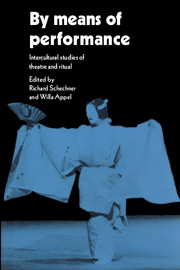Book contents
- Frontmatter
- Contents
- List of figures
- Notes on contributors
- Concerning Victor Turner
- Introduction
- 1 Are there universals of performance in myth, ritual, and drama?
- 2 Magnitudes of performance
- 3 Liminality: a synthesis of subjective and objective experience
- 4 The Yaqui deer dance at Pascua Pueblo, Arizona
- 5 A Yaqui point of view: on Yaqui ceremonies and anthropologists
- 6 Performance of precepts/precepts of performance: Hasidic celebrations of Purim in Brooklyn
- 7 The significance of performance for its audience: an analysis of three Sri Lankan rituals
- 8 What does it mean to “become the character”: power, presence, and transcendence in Asian in-body disciplines of practice
- 9 Korean shamans: role playing through trance possession
- 10 The practice of noh theatre
- 11 The profanation of the sacred in circus clown performances
- 12 Ethnographic notes on sacred and profane performance
- 13 The spatial sense of the sacred in Spanish America and the American South and its tie with performance
- 14 Space and context
- 15 The transformation of consciousness in ritual performances: some thoughts and questions
- 16 Universals of performance; or amortizing play
- Appendix
- Bibliography
- Index
10 - The practice of noh theatre
Published online by Cambridge University Press: 05 June 2012
- Frontmatter
- Contents
- List of figures
- Notes on contributors
- Concerning Victor Turner
- Introduction
- 1 Are there universals of performance in myth, ritual, and drama?
- 2 Magnitudes of performance
- 3 Liminality: a synthesis of subjective and objective experience
- 4 The Yaqui deer dance at Pascua Pueblo, Arizona
- 5 A Yaqui point of view: on Yaqui ceremonies and anthropologists
- 6 Performance of precepts/precepts of performance: Hasidic celebrations of Purim in Brooklyn
- 7 The significance of performance for its audience: an analysis of three Sri Lankan rituals
- 8 What does it mean to “become the character”: power, presence, and transcendence in Asian in-body disciplines of practice
- 9 Korean shamans: role playing through trance possession
- 10 The practice of noh theatre
- 11 The profanation of the sacred in circus clown performances
- 12 Ethnographic notes on sacred and profane performance
- 13 The spatial sense of the sacred in Spanish America and the American South and its tie with performance
- 14 Space and context
- 15 The transformation of consciousness in ritual performances: some thoughts and questions
- 16 Universals of performance; or amortizing play
- Appendix
- Bibliography
- Index
Summary
Dance, music, poetry, costumes, and masks combine in the noh theatre to create a performance which can be aesthetically impressive and emotionally profound. How is this art nurtured? What enables the beauty of noh to flower on the stage in a particular performance? What motivates the actors to devote their lives to nourishing a traditional art form? Are there new species of noh growing out of the old? And finally can noh, or aspects of noh be successfully transplanted to a climate as unfamiliar as that of the modern Western world? These are the questions we explore here.
Noh is today practiced in Japan by several hundred highly trained professionals, both actors and musicians. As a traditional performance system passed down in an unbroken line from generation to generation of practitioners since the fourteenth century, every aspect – text, melody, instrumentation, choreography, and costuming – has become codified. The current repertory is essentially the same as that performed in the sixteenth century, and today's performers are responsible for mastering its two hundred plays.
The phenomenal memorization that this mastery implies is aided by the structure of noh, for it is an art based on the manipulation of fixed modules of performance combined according to underlying principles. Although the basic vocabulary is limited, the variations are endless, so that each play, indeed each performance of a given play, offers fresh vision, new insights. The underlying rules may never be explicitly stated or taught, but they are subconsciously internalized during the course of training.
- Type
- Chapter
- Information
- By Means of PerformanceIntercultural Studies of Theatre and Ritual, pp. 167 - 193Publisher: Cambridge University PressPrint publication year: 1990
- 2
- Cited by



